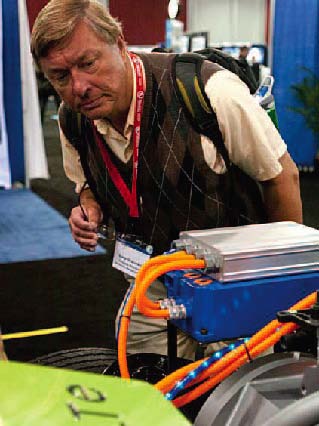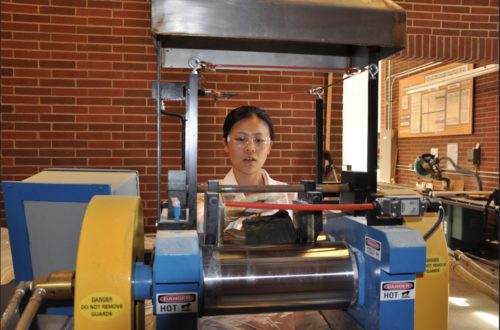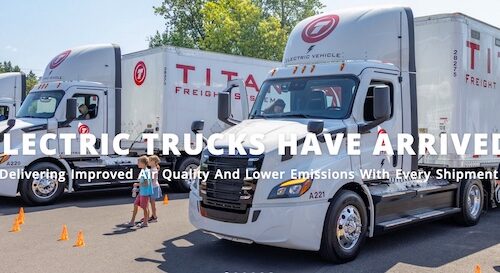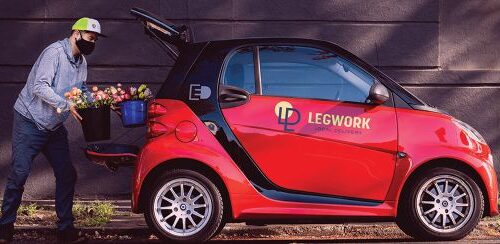There are some dreams that just never die and there are some people that will never quit pursuing them. Gary Graunke had such a dream and for the last 46 years he has been pursuing it.
The dream began in 1966, when two representatives from General Motors came to Gary’s high school and talked about electric drive fuel cell vehicles, which they believed were “just around the corner”. In an electronics shop course, Gary was already working with electric drive motors to propel a large three-wheeled robot, so it was easy for him to see the potential for an electric car. The quest was on, but he was a little ahead of the times.
Then in the 1970s, when the gas shortages struck and everyone was waiting in line for hours to buy 10 gallons of gas, Gary was once again seriously interested in electric vehicles (EVs). Luckily, there had been some advances in technology that enabled electric cars to once again be available. So he went electric car shopping, but could only find two that were actually available. One was not even capable of reaching 45 mph and the other cost more than his house. Gary’s dream was once again on hold.
Interest in EVs continued to grow along with technological advancements and some major automakers were developing programs and limited production models. In 2000, Gary ordered a Ford EV Ranger from his local dealer even though it cost three times more than the gasoline powered version of the same vehicle. After 34 years Gary’s dream was about to come true, or so it seemed. Unfortunately, six months after he had placed his order, Ford decided not to sell their Rangers but to lease them instead for a hefty $500 a month. The final blow to the deal was that at the end of the lease the truck had to be returned to Ford. Gary declined.
Not one to give up, Gary bought a US Electricar S-10 (a Chevrolet S-10 pick up that had been converted to electric drive) on Ebay. It came with some minor problems, but Gary soon had those fixed and he drove it for about two years. He also rented a Honda EV and a General Motors EV1, but these vehicles were eventually called in by their makers and crushed (for more on this see the film “Who Killed the Electric Car”).
By now two major changes had come into play: Honda and Toyota introduced their hybrid models, and there were enough people converting gasoline cars into electric ones that there were reliable components available. Gary dove in. After a lot of reading, participating in online forums, and studying possible vehicles for conversion, he settled on a 2000 Honda Insight hybrid. He spent six months converting it to 100% electric drive and it became his daily driver for the next eight years.
The Insight didn’t have the driving range to meet all of Gary’s driving needs so in 2008 he purchased a Toyota Prius, which he then modified to have a larger battery that could be charged with an ordinary 110 V outlet (PHEV). This resulted in a car that delivered 70 – 85 mpg with no range limitations. Gary was getting close to his dream with the Insight for short trips and his Prius for longer runs, but he wasn’t there yet.
It was also during this time that the world of electric vehicles was forever changed by Elon Musk of Tesla Motors and Carlos Goshn of Nissan. Musk’s roadster showed that an EV could have a driving range approaching that of a gas-powered car and Goshn’s Leaf was the first production EV to find its way to market in almost 90 years. Once more Gary stepped up. He purchased a 2011 Leaf and is participating in the Department of Energy’s study of Leaf owners. As Gary says of his Leaf, “There is room for improvement, but it is a great start…”.
The ever expanding West Coast Electric Highway charging infrastructure in Oregon has allowed the Leaf to serve nearly all of his transportation needs—his excellent plug-in Prius languishes in his driveway. An upgraded Nissan “emergency” portable charger that comes with the Leaf has allowed Leaf owners to go beyond the charging network to places as remote as John Day using RV parks, dryer outlets, etc. A recently added solar array on his garage has meant a minimal electric bill for the summer–$10 a month to power his house as well as his electric cars.
After driving a Tesla Roadster with its 200+ mile range, Gary feels that Tesla’s model S sedan is in line with his dream car vision with the exception of its $80,000+ price tag. The relentless improvements in battery technology will make cars with the range of the Tesla much more affordable within a few years. Once again patience is required. In the meantime, Gary notes that the GM Volt and Toyota plug-in Prius serve as effective transition vehicles, doing everything conventional vehicles do, only more efficiently.
In the quest for his dream car, Gary attended many events with other non-profit groups. It became apparent to him that the EV offered a solution to the problems of air pollution, climate change, and the economic and national security aspects of imported oil. This social relevance aspect of the EV, which is above and beyond its mechanical superiority and its lower cost of operation, caught Gary’s fancy and set him on a much broader quest: mass adoption of the EV.
Gary is now a tireless advocate for the adoption of electric drive as the future of personal transportation. Countless hours have been spent in meetings, conferences, vehicle demonstrations, presentations, testifying before the legislature, and other behind the scenes efforts to make his real dream come true: an EV in every garage. With all of the new models coming to market and as the recharging infrastructure nears critical mass on the west coast, we now have the freedom to choose EV’s as a practical alternative for many drivers. While social inertia, the perceived issue with “range anxiety”, and an unfriendly media are obstacles to rapid adoption of EV’s, their adoption rate in the first year has been twice that of hybrid vehicles.
Gary wonders what opportunities and changes will come next. Will it be integrating EV batteries with the smart grid to even out the fluctuations inherent with renewable energy generation? Perhaps it will be combining natural gas and plug-in electric drives to power larger vehicles. There are many ways that the young and young-at-heart can become more adaptable, resilient, and efficient in order to support more people with fewer fossil resources and less impact on the planet.
And so Gary just keeps on going and going and going and….





